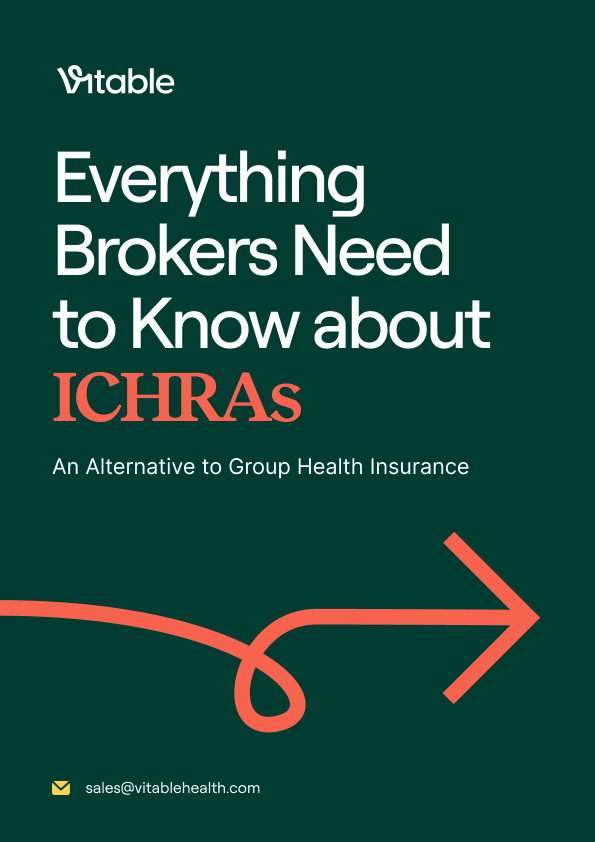What Is Employer-Sponsored Health Insurance?

According to the United States Chamber of Commerce, employer-sponsored health insurance represented the single largest source of health coverage in the U.S. in 2023, providing health benefits to more than 160 million Americans. Today, this form of health insurance is considered the backbone of healthcare in the U.S., with health benefits being a deciding factor when choosing where to work for as many as 80% of working Americans.
There’s no denying that employer-sponsored health insurance is one of the best options to support employee health and satisfaction, while keeping costs down over time with a healthier workforce. However, it can become overwhelming for employers to keep track of the different terms, requirements, and types of employee health benefits. That’s why we’ve prepared a guide with all the information you need to know about employer-sponsored health insurance.
In this article, you’ll learn:
- The importance of employer-sponsored health insurance
- Key mandates under the Affordable Care Act (ACA) for Applicable Large Employers (ALEs)
- Different types of employer-sponsored health insurance options
- Definitions of common employee health insurance terminology
- How you can leverage experts like Vitable to streamline your benefits administration
What is Employer-Sponsored Health Insurance?
Employer-sponsored health insurance is defined as health coverage that's provided to employees (and their dependents) by their employer, sometimes in partnership with an insurance provider, depending on the type of insurance plan. According to the Kaiser Family Foundation (KFF), 60.4% of people under the age of 65 (approximately 165 million Americans) had employment-sponsored health insurance in 2023.
Employees receive coverage as part of their compensation package and are generally reimbursed for their eligible medical expenses. Employer-sponsored health insurance can provide a variety of employee health benefits, including coverage for preventative services, primary care and mental health services, prescription drugs, and more. These plans also often extend to spouses and dependents to provide comprehensive protection for entire families, although additional costs may apply.
Employer-sponsored health insurance is usually more affordable than individual health plans because employers typically share the cost of premiums with employees. The 2024 Employer Health Benefits Survey from KFF reported average annual premiums for employer-sponsored health insurance in 2024 of $8,951 for individual coverage and $25,572 for family coverage. Workers with individual coverage were responsible for contributing 16% of the premium, while those provided with family coverage contributed 25%. The remaining amounts were provided by employers.
The Importance of Employer-Sponsored Health Insurance
Although offering employee health insurance is not mandatory for all types of businesses, doing so can be extremely beneficial for both employers and employees alike! Essentially, it’s a win-win situation because your team gains peace of mind knowing they have a financial safety net for their well-being, while you benefit from a healthier and more productive workforce.
Key Benefits of Employer-Sponsored Health Insurance Plans
For Employers
• Attract and retain top talent by boosting employee loyalty
• Increase employee productivity with access to preventative and wellness programs
• Reduce taxable income by offering tax-advantaged coverage options
For Employees
• Greater financial security with reduced out-of-pocket medical expenses
• Improved health and wellness through comprehensive benefits coverage
• Access to critical healthcare services offers peace of mind
• Reduce taxable income with pre-tax
What is the Affordable Care Act (ACA), and How Does it Affect Employer-Sponsored Health Insurance?
The Affordable Care Act (ACA) represents a historic milestone in U.S. healthcare reform. The ACA was officially passed in March 2010 and aimed to make health insurance more affordable and accessible nationwide [6]. The ACA served to benefit employees by expanding their insurance coverage options and offering certain tax advantages for employers, depending on the size and structure of their workforce.
These are the three primary goals of the ACA:
- Offer subsidies, also known as premium tax credits, to help low-income individuals and households between 100% and 400% of the federal poverty line (FPL) afford insurance.
- Allow states to expand their Medicaid coverage to all adults with income below 138% of the FPL.
- Support innovations in medical care delivery methods to lower healthcare costs in the U.S.
Under the ACA, most insurance plans are now required to cover essential employee health benefits and preventive services at no cost to policyholders. These apply to health plans sold on the Health Insurance Marketplace, which is a federal platform that offers insurance plans for individuals, families, and small businesses to explore and compare.

Download 2025 Employer Guide to ICHRA
Vitable’s ICHRA Guide gives employers a clear, step-by-step resource for building smarter, ACA-compliant benefits.
This guide explains how ICHRAs work, who qualifies, and how Vitable simplifies setup, onboarding, reimbursements, and compliance — while giving employees more flexibility, control, and care.

Download Vitable’s 2025 Broker’s Guide to ICHRA
The Broker Guide to ICHRAs is a comprehensive resource that helps brokers understand, sell, and manage Individual Coverage HRAs with confidence.
This guide covers everything from compliance and class design to administration flows, case studies, and how Vitable streamlines quoting, enrollments, and reimbursements for brokers, employers, and employees.
ACA Requirements for Applicable Large Employers (ALEs) Offering Employee Health Benefits
Employers who had an average of 50 or more full-time employees (including full-time equivalent [FTE]) employees in the previous calendar year are considered to be an applicable large employer (ALE) under the ACA. ALEs are legally required to provide employer-sponsored health insurance that covers pre-existing conditions, preventive care services, and mental health and substance abuse treatment.
Visit our article here for steps to determining whether your business is an ALE.
If this requirement is met for the current calendar year, the ALE must ensure they meet the following core mandates set by the ACA.
- Offer Minimum Essential Coverage (MEC):
Applicable large employers must offer minimum essential coverage (MEC) to at least 95% of their workforce or face penalties. Learn more about MEC here.
- Ensure Affordability:
In 2025, an employer-sponsored health plan is considered affordable as long as employees pay no more than 9.02% of their household income toward health coverage.
- Reporting Requirements:
ALEs must submit Forms 1094-C and 1095-C to report whether they offered affordable MEC plans with minimum value to their full-time employees. Employers are also required to report the value of the health insurance coverage provided to each employee on their Form W-2.
- Payment and Provisions:
If ALEs fail to meet ACA compliance requirements, they may be penalized with a significant employer shared responsibility payment of $7,250 per employee.
Understanding Open Enrollment for Employer-Sponsored Health Insurance
Each year, the Health Insurance Marketplace has an open enrollment period (starting on November 1), during which policyholders can buy or switch insurance plans. It’s usually limited to a few weeks, and if employees miss out, they may have to wait until the next open enrollment period to make any changes. The open enrollment period applies to any employee-sponsored health insurance plans.
Outside these dates, enrollment is limited only to those under these specific circumstances:
- Marriage
- Divorce
- Becoming a parent
- Lost a job that provided employee health insurance coverage
Employee-Sponsored Health Insurance: Defining Key Terms
Many employer-sponsored health plans operate under PPO or HMO models that may include fee-for-service elements, which require the insured consumer to pay a premium in exchange for the coverage of medical expenses, but they can also leverage negotiated rates and cost-sharing structures. Below are a few common terms used in health insurance plans.
Definitions:
- Premiums are the amount paid regularly to maintain the insurance policy.
- Deductibles are the amount that is required to be paid out-of-pocket before insurance coverage becomes active.
- Co-payments (or copays) are fixed out-of-pocket fees for specific services.
- Out-of-pocket maximums represent the highest amount an individual will pay in a given year.
- Coinsurance is a percentage of healthcare service bills that is paid to the insurance provider after reaching the deductible.
- Provider network is a list of doctors, other health care providers, and hospitals that a health insurance plan partners with to provide medical care to its members. Providers that are not contracted under the plan are “out-of-network providers.”
Types of Employer-Sponsored Employee Health Insurance Options
There are several health insurance options to choose from, all of which are designed to protect your employees' health while helping them manage medical costs.
1. Group Health Insurance Plans
When coverage under a policy or plan is offered by a sponsoring group, such as an employer, it is referred to as group health insurance. With this type of employer-sponsored health insurance, companies negotiate with insurance providers to offer one or multiple comprehensive health plan options for employees to select during open enrollment.
These plans provide broad networks of healthcare providers and can include both PPO (Preferred Provider Organization) and HMO (Health Maintenance Organization) options.
Both employees and employers pay their respective shares of the premium to the insurance provider, making these plans generally more affordable than buying individual coverage directly from the insurer or in the ACA marketplace. Group plans also typically have health insurance deductibles and coinsurance.
Employers may choose to offer a low-deductible group health plan or a high-deductible health plan (HDHP), which also qualifies for an accompanying health savings account (HSA).
2. Health Reimbursement Arrangements (HRAs)
Health Reimbursement Arrangements (HRA) are tax-advantaged employer-funded accounts that reimburse employees for eligible medical expenses, like their health insurance premiums. This arrangement allows companies to control costs while giving employees freedom to choose their healthcare providers and services, with several options available for different types of employers.
The most common types of HRA to consider for your business:
- Individual Coverage HRA (ICHRA): This option allows employers of any size to offer individual health insurance coverage to employees while providing reimbursement for premiums and other eligible medical expenses.
- Qualified Small Employer HRA (QSEHRA): This type of HRA is designed only for small businesses with fewer than 50 full-time employees. It allows eligible employers to reimburse employees for qualified medical expenses, including health insurance premiums, up to a set annual limit.
- For 2025, the contribution limits for a QSEHRA are $6,350/year for individual coverage and $12,800/year for family coverage.
- For 2025, the contribution limits for a QSEHRA are $6,350/year for individual coverage and $12,800/year for family coverage.
- Excepted Benefit HRA (EBHRA): The EBHRA is a limited-purpose HRA that provides additional benefits beyond the primary health plan, covering expenses like vision, dental, or specific wellness services.
3. Minimum Essential Coverage (MEC) or Minimum Value Plans (MVP)
Minimum Essential Coverage (MEC) plans cover basic preventive care while meeting the ACA’s MEC requirements, which aim to provide essential coverage at affordable prices. MEC plans comply with Part A of the ACA, which requires applicable large employers to offer coverage to at least 95% of full-time workers or full-time equivalents.
This typically includes basic preventative and wellness services, helping businesses avoid a hefty penalty fee of $2,900 per employee if MEC requirements are not met.
Minimum value plans (MVP), on the other hand, are designed to comply with Part B of the ACA mandate, which MEC plans typically do not meet.
An MVP must have two minimum value standard requirements:
- Be designed to cover at least 60% of the anticipated expenses for an average enrollee.
- Ensure coverage for inpatient and outpatient care, emergency services, maternity care, and other specific conditions.
The U.S. Internal Revenue Service (IRS) imposes a substantial penalty fee of $4,350 per full-time worker if employers provide coverage that does not meet the minimum value standard. However, this penalty only applies to certain employees with coverage through the marketplace.
4. Ancillary Benefits
Sometimes, major medical plans will not cover certain health services that employees still need to use regularly. For example, these could include vision insurance, dental insurance, and short- or long-term disability insurance.
Ancillary benefits serve as add-on health benefits offered by an employer to cover additional medical expenses, helping to fill coverage gaps in traditional insurance plans. These benefits are optional and customizable, allowing employers flexibility in what they choose to offer and how.
5. Health Savings Accounts (HSA)
Health savings accounts (HSAs) are a type of tax-advantaged savings account used to pay for qualified medical expenses not reimbursed by high-deductible health plans (HDHPs), a type of group health insurance.
Contributions to an HSA can be made by either the employee or the employer using pre-tax dollars, which can be claimed as a federal tax deduction to reduce taxable income. Any amounts taken out of an HSA are tax-free as long as they pay for qualified medical expenses listed in IRS Publication 969.
For 2025, the maximum contribution set by the IRS for an HSA is $4,300 for an individual and $8,550 for families.
To qualify for an HSA, employees must meet these eligibility standards established by the US IRS:
- Have a qualified high-deductible health plan (HDHP)
- Have no other health coverage
- Not be enrolled in Medicare
- Not be claimed as a dependent on someone else’s tax return
6. Flexible Spending Accounts (FSA)
A Flexible Spending Account (FSA) is a tax-advantaged account that allows employees to set aside pretax dollars from their paycheck to cover qualified healthcare expenses incurred during the plan year. Eligible expenses typically include copayments, deductibles, prescription medications, and other out-of-pocket costs not covered by health insurance. Employers can offer FSAs alongside other benefit options, including Health Reimbursement Arrangements (HRAs).
The primary difference between the two is that FSAs are funded by employees, while HRAs are funded solely by employers. FSAs involve salary reduction agreements and are subject to annual IRS contribution limits. HRAs, on the other hand, do not involve salary reduction—they are employer-funded reimbursements for eligible expenses.
7. Health Stipends
Health stipends are sometimes offered by employers looking for an alternative to traditional health insurance plans. This stipend is an extra amount in an employee’s paycheck and is considered additional taxable income. Unlike an HRA, health stipend funds can be used to cover any expenses, including health insurance premiums, out-of-pocket medical costs, or personal expenses.
However, because health stipends are considered financial supplements, they are not subject to the same tax advantages as employer-sponsored health insurance. Instead, employees using these additional funds must pay federal, state, and payroll taxes on them. In terms of taxes, health stipends are seen as regular wages and may push employees into a higher tax bracket due to an increased taxable income.
Conclusion
Employer-sponsored health insurance has long been a staple in U.S. healthcare, with most workers considering it their top priority when deciding whether to stay with a particular employer. Although traditional health plans are becoming more expensive, businesses now have multiple options to provide competitive health coverage that doesn’t break the bank.
These vary from traditional group health plans to modern alternatives, such as HRAs, HSAs, and FSAs. However, for employers to make an informed decision on which benefits approach is best suited to their employees’ needs, it’s important to understand the different types of employer-sponsored health insurance plans, their tax implications, and regulatory compliance requirements.
If this seems overwhelming, you’re not alone! Leveraging expert knowledge from affordable employee health benefits administrators like Vitable Health can quickly help streamline your company’s benefits approach while keeping costs down.
Vitable: A Better Way to Manage Benefits Administration
Vitable is the future of affordable employee benefits with innovative healthcare solutions that put your employees’ health first. By relying on Vitable for outsourced benefit administration, employers can choose from several flexible, ACA-compliant coverage plans, including ICHRA and QSEHRA options and Minimum Essential Coverage (MEC) + Minimum Value Plans.
Even more, each of these plans is seamlessly integrated with the Vitable Direct Primary Care (DPC) membership model, which provides employees convenient same-day or next-day access to essential primary care services with no copays or deductibles required.
Ready for better health benefits for your business? Let Vitable handle the heavy lifting so you can focus on what matters most: building a better workplace for your team. Book a free consultation today or use the form below to learn more!
Ready to learn more?
Stay ahead with the latest insights on healthcare, benefits, and compliance—straight to your inbox.
Get a quote
Get a personalized health benefits quote tailored to your company’s unique needs.
Vitable helps employers provide better healthcare to their employees and dependents by improving accessibility, cost, and quality.
